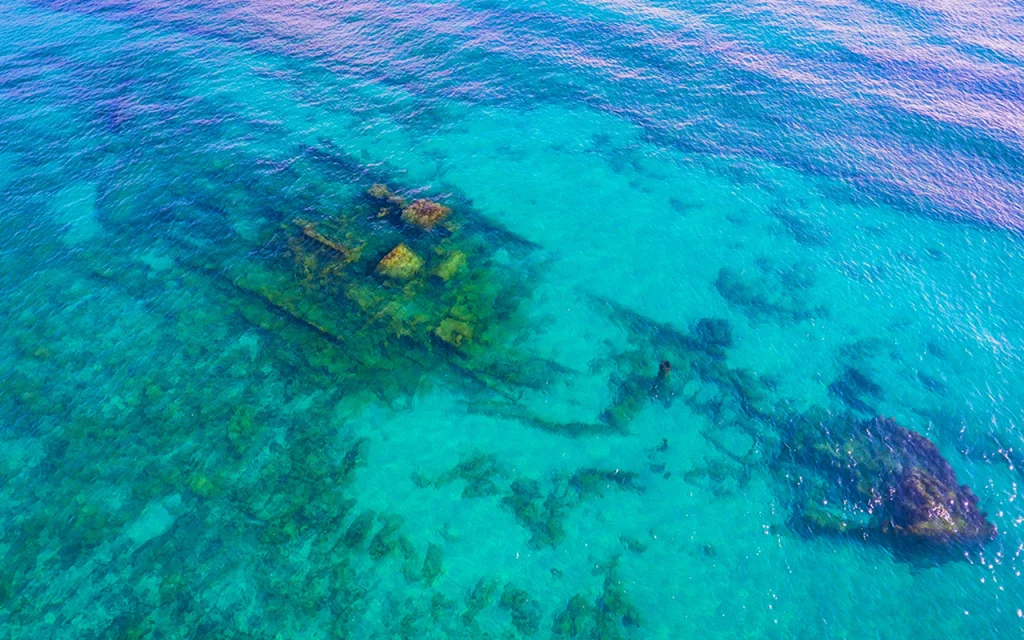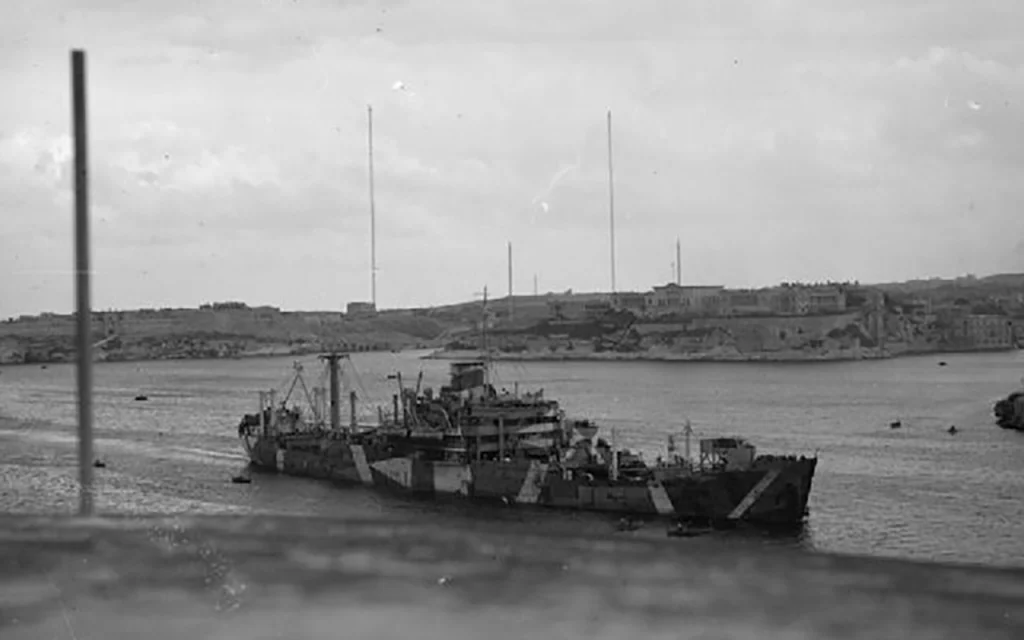Table of Contents

The SS Breconshire was a schooner-rigged, iron-hulled steamship built in Sunderland, England, in 1884. It was 300 feet long and 37 feet wide, with compound engines of 350 horsepower complementing its sail power. The ship was commanded by Captain Robert Taylor and had a crew of 24 men, including Second Officer Edwin Curling.
Article at a Glance
- The SS Breconshire sank on April 30, 1894, after hitting a reef off the coast of Vero Beach, Florida.
- The wreck is located a quarter mile offshore, in front of Costa d’Este, with the bow visible at low tide.
- It’s a popular site for snorkeling and diving, accessible via kayak or paddleboard.
- The wreck sits in 16-20 feet of water, making it suitable for both experienced and novice divers.
- Marine life around the wreck includes sea turtles, snook, snapper, and various tropical fish species.
- The ship was 300 feet long, 37 feet wide, with compound engines of 350 horsepower.
- Vero Beach Watersports offers guided snorkeling tours to the wreck, providing gear and transportation.
SS Breconshire Shipwreck Location Coordinates and Depth
Depth
The maximum depth of the wreck site is between 16 and 20 feet (5 to 6 meters) below the surface.
Location Coordinates
The SS Breconshire shipwreck is located off the coast of Vero Beach, Florida. The wreck is situated approximately a quarter mile from the shore, near the Ocean Grill Restaurant. The coordinates for the wreck are:
- Latitude: 27.6453° N
- Longitude: 80.3733° W
What to Scuba Divers Say About This Ship
Accessibility and Depth
The SS Breconshire is a popular destination for scuba divers and snorkelers due to its shallow depth, with the wreck sitting in 16-20 feet of water. This makes it easily accessible for both experienced and beginner divers.
Marine Life and Ecosystem
The wreck has become an artificial reef, attracting a diverse array of marine life. Divers report seeing sea turtles swimming over the wreck, as well as snook, snapper, angelfish, wrasse, and sergeant major fish. The wreck offers shelter and habitat for many tropical species.
Photographic Opportunities
The wreck’s proximity to shore and shallow depth make it an ideal spot for underwater photography and filming. Divers have captured stunning footage and images of the wreck and its surrounding marine life.
Historical Significance
As one of the few remaining 19th-century shipwrecks in the area, the SS Breconshire holds historical significance for divers interested in maritime history. The wreck serves as a reminder of the ship’s ill-fated final voyage in 1894.
What Kind of Marine Life Can Be Found on The Ship
Fish Species
- Snook and snapper pass by the wreck on their way to the nearby Indian River Lagoon
- Schools of tropical fish like elegant angelfish, blue headed wrasse, and sergeant major fish take shelter in the hull and girders of the wreck
- Vibrant schools of fish can be seen swimming around the wreckage
Other Marine Life
- Sea turtles swim lazily over the wreck, munching on the algae and greenery growing on it
- Weary stingrays stop by to rest in the security of the aquatic plants growing beside the wreck
- Crabs, snails, and other small crustaceans and mollusks inhabit the wreck
- Jellyfish can also be encountered while snorkeling the wreck site
Key Information
| Category | Information |
|---|---|
| Ship Name | SS Breconshire |
| Sinking Date | April 30, 1894 |
| Location | Quarter mile offshore, Vero Beach, Florida |
| Coordinates | 27.6453° N, 80.3733° W |
| Depth | 16-20 feet (5-6 meters) |
| Ship Dimensions | 300 feet long, 37 feet wide |
| Engine Power | 350 horsepower compound engines |
| Visibility | Bow visible at low tide |
| Marine Life | Sea turtles, snook, snapper, tropical fish |
| Access Method | Kayak, paddleboard |
| Tour Provider | Vero Beach Watersports |
| Tour Includes | Kayak, snorkeling gear, guide |
| Best Conditions | Summer months, west winds |
| Nearby Landmark | Costa d’Este |
What Makes The SS Breconshire a Unique Diving Experience
- Accessibility: The wreck is located just a quarter mile from the shore, making it easily accessible for both scuba divers and snorkelers. The shallow depth of 16-20 feet also makes it suitable for beginners.
- Historical Significance: The SS Breconshire is one of the oldest natural disaster shipwrecks still accessible to divers, providing a glimpse into maritime history. The wreck is a reminder of the ship’s ill-fated final voyage in 1894.
- Marine Life: The wreck has become an artificial reef, attracting a diverse array of marine life. Divers can see sea turtles, snook, snapper, angelfish, wrasse, sergeant major fish, and other tropical species. The wreck’s proximity to shore and shallow depth make it an ideal spot for underwater photography and filming.
- Guided Tours: Local dive services offer guided snorkeling and scuba diving trips to the wreck, providing an educational and safe experience for visitors. These tours often include equipment and instruction, making it accessible to both experienced and beginner divers.
- Year-Round Diving: The wreck is accessible year-round, with the best diving conditions typically found during the summer months when west winds flatten out the seas. Strong east winds can reduce visibility, but the wreck remains accessible even in these conditions.
What is The Full History of This Ship
Ship Construction and Early History
The SS Breconshire was an iron-hulled, schooner-rigged steamship built in 1884 in Sunderland, England. Originally named the SS Numida, the ship was 300 feet long and 37 feet wide, with compound engines of 350 horsepower that complemented its sail power. In 1886, the ship was purchased by Jenkins & Co., a London-based company, and renamed the SS Breconshire after a historic county in South Wales. Under Jenkins & Co., the Breconshire typically ran routes from England to the Mediterranean and New York, transporting cargo.
The Final Voyage and Sinking
On April 25, 1894, the SS Breconshire departed New York with a cargo destined for Tampa, Florida. The ship was commanded by Captain Robert Taylor and had a crew of 24 men, including Second Officer Edwin Curling. Unfamiliar with the waters off the Florida coast, Captain Taylor ordered navigational charts but failed to check them until it was too late. On the night of April 29, 1894, the Breconshire struck a reef off the coast of Vero Beach, causing the hull to split and the ship to sink in 20 feet of water. Fortunately, the entire crew was able to escape the sinking vessel in lifeboats.
Aftermath and Legacy
After the sinking, Captain Taylor and Second Officer Curling faced trial in London. They were found responsible for the negligence that led to the $75,000 loss (equivalent to $2.5 million today) and had their certificates suspended for six months. The wreckage of the SS Breconshire, now known as the “Boiler Wreck,” remains on the ocean floor off Vero Beach. Over the years, the wreck has become an artificial reef, attracting a diverse array of marine life. Today, the wreck is a popular destination for snorkelers and scuba divers exploring the shallow waters and observing the thriving underwater ecosystem.

What Historical Features Can Still Be Identified on The SS Breconshire Wreck
Protruding Boiler
- The wreck is known locally as the “Boiler Wreck” because the ship’s boiler was once visible above the water, serving as a landmark.
- Over time, the wreck has settled further into the sand, and the boiler is now submerged below the surface.
Hull and Girders
- Much of the 300-foot ship’s hull and girders are still protruding from the ocean floor and visible to divers and snorkelers.
- These structural elements of the ship have become covered in algae and serve as habitat for a variety of marine life.
Masts
- The ship’s masts are still partially visible, sticking up from the wreckage and providing shelter for fish like snook and snapper.
While the wreck has deteriorated over the 130+ years since it sank, these key structural features of the historic SS Breconshire can still be identified by those exploring the site.
What Safety Measures Are in Place for Divers Visiting the SS Breconshire
Guided Tours
Local dive operators offer guided snorkeling tours to the wreck site, which include kayaking out to the wreck location and providing snorkeling gear like fins, masks, and snorkels. These guided tours ensure divers are properly equipped and familiar with the site.
Shallow Depth
The SS Breconshire wreck sits in relatively shallow water, with a maximum depth of 16-20 feet (5-6 meters). This shallow depth makes the wreck accessible for both experienced and beginner divers, reducing safety risks.
Weather and Water Conditions
Snorkeling tours are only offered based on favorable weather and water conditions.Operators likely monitor conditions closely to ensure it is safe for divers to visit the site.
Diver Education and Certification
While the shallow depth makes the wreck accessible, divers should still be properly certified and educated on safe diving practices. Organizations like the British Sub-Aqua Club provide comprehensive guides on safe diving that cover essential topics like equipment, planning, and emergency procedures.
Dive Shops That Prove Diving Trips to This Shipwreck
Vero Water Sports
Vero Water Sports offers guided snorkeling tours to the SS Breconshire wreck, which they refer to as the “Boiler Wreck”. Their tours include kayaking out to the wreck site and providing snorkeling gear like fins, masks, and snorkels.
Other Potential Dive Shops
While not explicitly mentioned, it’s likely that other dive shops in the Vero Beach area also offer diving and snorkeling trips to the SS Breconshire wreck, given its popularity as a local dive site. Some other potential options include:
- Vero Beach Dive Center
- Ocean Pro Dive Center
- Scuba Diving Vero Beach
- Vero Beach Scuba
Central Florida Wrecks
- SS Breconshire
- Georges Valentine
- Hog Heaven
- Urca De Lima
- USS Rankin
- Ana Cecilia
- United Caribbean
- USS Mindanao
- The Laertes
- Berry Patch Tug Wreck
- The Liberty Ship
- The Ana Cecilia
- The Cities Service Empire
- USS Accokeek
- The Tortuga Wreck
- Princess Ann Wreck (Palm Beach)
- Okinawa Wreck (Pompano Beach)
- MG-111 Wreck (Jupiter)
- Lady Luck Wreck (Pompano Beach)
- Rodeo 25 Wreck (Pompano Beach)
- Lowrance Wreck (Pompano Beach)
- RSB-1 Wreck (Deerfield Beach)
- Rebel Wreck (Deerfield Beach)
- Noulla Express Wreck (Fort Lauderdale)
- Sucre Wreck (Fort Lauderdale)
- Captain Tony Wreck (Pompano Beach)
- Peter McAllister Wreck (Pompano Beach)
- Guy Harvey Wreck (Fort Lauderdale)
- Quallman Tugs Wreck (Pompano Beach)
- Miller Lite Wreck (Pompano Beach)





